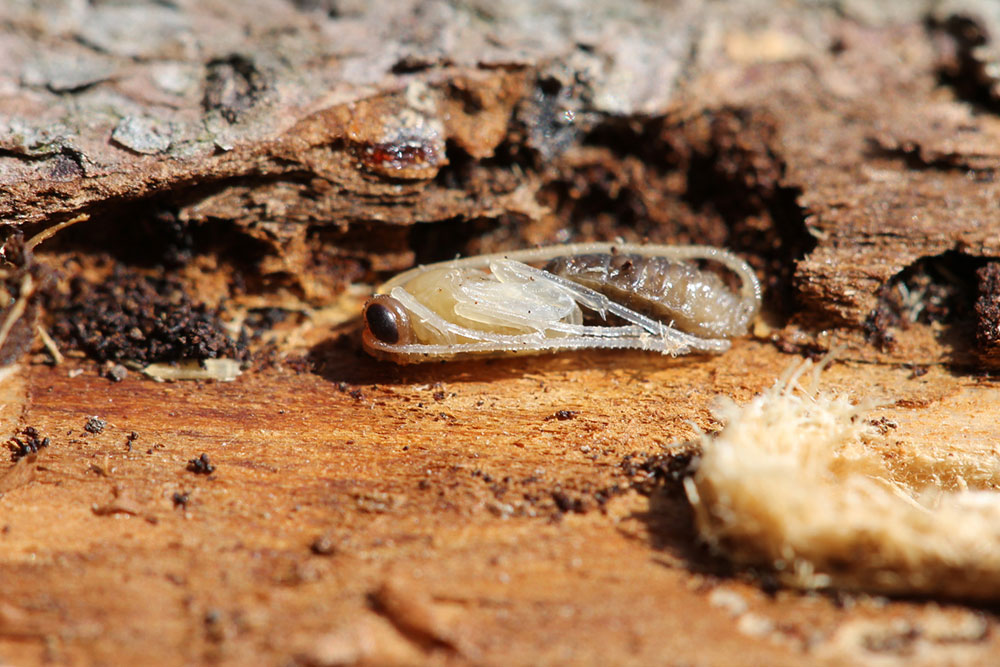Tree Borers – Types, Signs of Infestation, and Remedies
Wood borers or tree borers are a group of insects known to feed on trees and woody plants. Usually, several varieties of insects, such as moths, beetles, and wasps and their larvae, are classified as wood borers. These not only attack the trees but also inhabit them. Typically, wood-boring bugs and insects are known to be primary and secondary invaders. Primary invaders attack healthy plants, while the secondary invaders target weak or dead trees.
Common types of tree borers
1. Flat-headed wood borers
These are large beetle families known to target weak or recently transplanted trees. Flat-headed wood borers are also known as metallic wood-boring beetles or jewel beetles because the adult beetles have distinct metallic colors and are shaped like boats.

2. Round-headed borers
Also called longhorn beetles, these insects have antennae that appear bigger than their bodies. The larvae are usually round-shaped. These borers damage trees by leaving behind dust-like frass and sap on branches and trunks. Usually, round-headed borers are secondary invaders that attack weakened or dead trees.
3. Weevils
Unlike other types of wood borers, which dig tunnels in the wood, weevils create hollow cavities. They also attack the bases and roots of woody plants instead of the trunks and branches.
4. Wood-boring moth caterpillars
Since the adult form of these are clearwing moths, these borers are also sometimes called clearwing borers. They hatch in the bark of trees and start burrowing holes in them. They begin to feed on the wood by tunneling into them.
Signs of tree borer infestation
To determine ways to get rid of these insects, it is crucial to identify some of the common signs of infestation. Here are common signs that one must keep an eye out for:
1. Tunnel holes
This is one of the most common signs. The insect creates the holes by tunneling into the bark of the tree. These holes can be round, semicircular, or oval, depending on the species of the borer.
2. Frass
Sometimes, borer holes look similar to those made by woodpeckers. One way to distinguish between the two is to look for frass, which is the excrement left behind by wood borers as they feed on the tree’s wood. It looks like sawdust.
3. Dead limbs or cracked bark
Tree borers usually make tunnels and holes in the inner layers of the tree bark, where nutrients and water are transported. When this layer is damaged, the tree does not get enough nutrients. As a result, the bark begins to crack, and tree limbs start to die and fall off.
4. Oozing sap
Also known as gummosis, it occurs when the sap oozes out of the holes and tunnels made by the borers. This usually happens to trees bearing stone fruits such as peaches, apricots, mangoes, etc.
Remedies to get rid of tree borers
1. Use chemicals
Depending on the variant of the tree borer, different types of insecticides and chemical solutions are available. Contact insecticides can be used to kill active tree borers. Besides this, chemical-based soil treatments can also be done to kill off the larvae and prevent further infestation. But before using any pesticide or insecticide, it is important to check the standards issued by the state. Every state has its own standard guidelines for the legal use of pesticides.
2. Prune the affected branches
Sometimes, tree borers typically target only the branches of a tree. In such situations, it is useful to prune and trim the affected branches strategically. This helps eliminate and reduce the pests. It slows down and often stops the damage from spreading. One can take the help of a tree trimming specialist who can use the best pruning methods to avoid further damage or disturbance to the tree.
3. Use manual methods
In cases of moth infestation, where large holes are made to lay eggs, stiff wires can be inserted into these holes. This can kill the larvae within the bark of the tree. While this method is tedious, it definitely helps when one wants to avoid using chemicals or cutting off the tree.
4. Replace the tree
When the damage inflicted by the borers becomes visible, it is quite late to save the tree. In such cases, it is better to completely remove and replace the tree.
Ways to prevent tree borer infestation
Often, the best remedy for getting rid of tree borers is to prevent their infestation. This can be done in the following ways:
1. Take proper care of the trees
Tree borers usually attack weak or stressed trees and plants. So, it is quite easy to prevent infestation by simply watering and fertilizing them using the right methods. Besides this, it is crucial to pay special attention to recently transplanted trees, which are at a higher risk of infestation.
2. Pick the right tree species
Whenever new trees are planted, it can be helpful to choose the ones that wood borers in that specific geographic region do not target. Find out about the species of trees less susceptible to infestation and plant these instead of the vulnerable ones.
3. Prevent tree damage
Equipment like mowers can often cause external damage to trees, making them more vulnerable to borer infestation. So, whenever a tree is damaged accidentally, it is crucial to treat the wound with pruning or wound paint.
